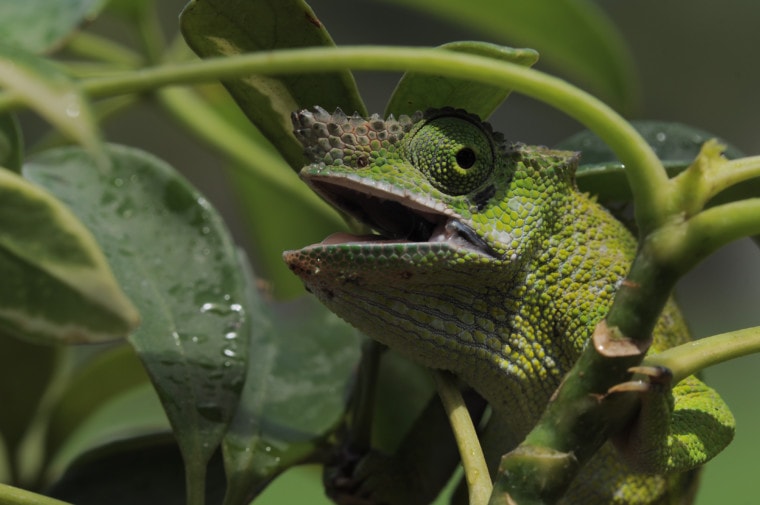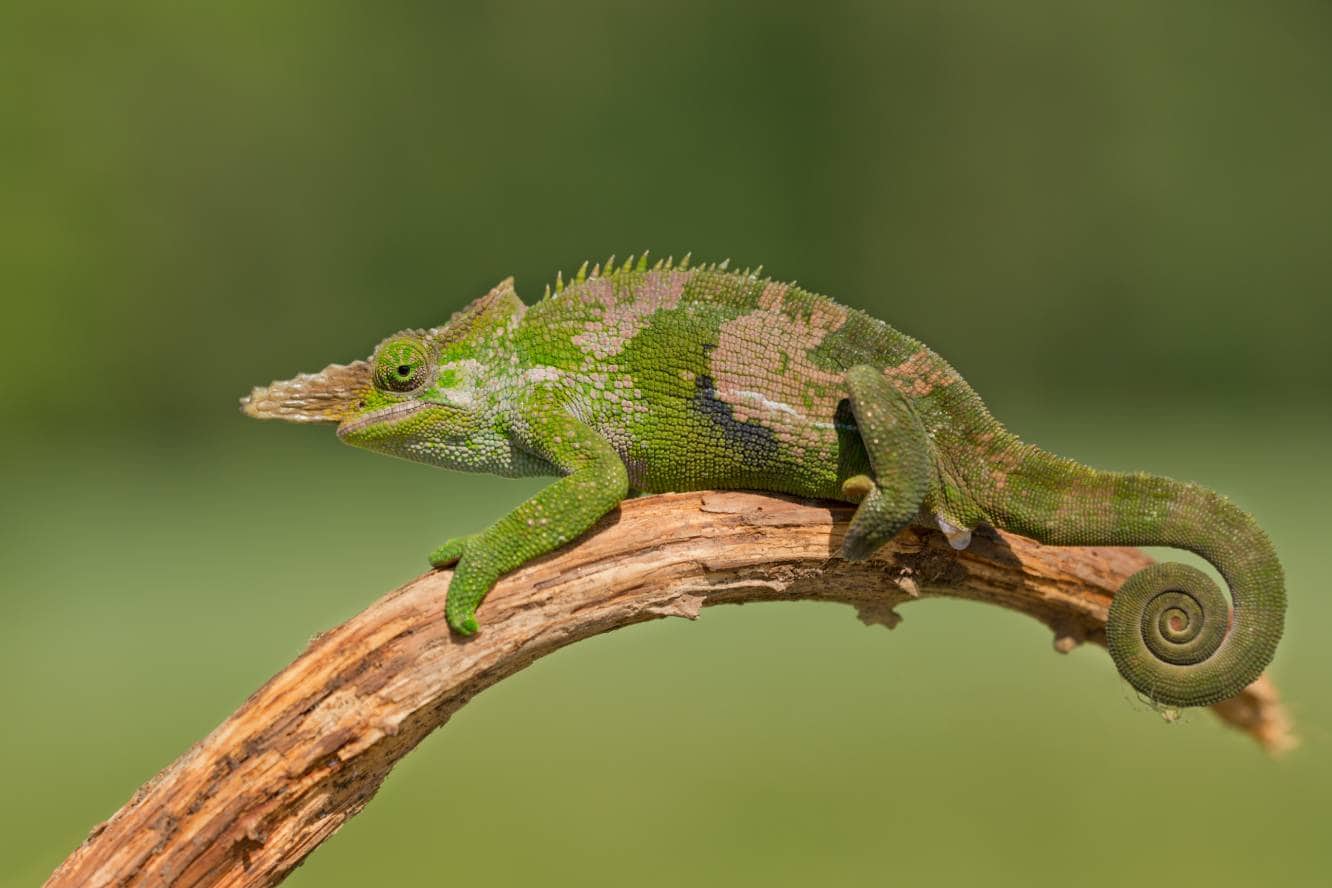
There are currently over 180 different types of chameleons in the world. They all vary in size, color, and overall appearance, but there are only a few that are kept in captivity as pets. Not all chameleons make good companions, and some require a lot more work than others. One of the most popular chameleons to keep as a pet is the Fischer’s Chameleon.
 Quick Facts about Fischer’s Chameleon
Quick Facts about Fischer’s Chameleon
| Species Name: | Kinyongia fischeri |
| Family: | Chamaeleonidae |
| Care Level: | Moderate |
| Temperature: | 75°F |
| Temperament: | Shy, territorial |
| Color Form: | Lime green, forest green, or brown with patterns and spots. |
| Lifespan: | 3-5 years |
| Size: | 7.5-9.5 inches |
| Diet: | Insects, small mammals |
| Minimum Tank Size: | 20 gallons |
| Tank Set-Up: | Sturdy tank with lots of light and branching pieces of wood. |
Fischer’s Chameleon Overview
The Fischer’s Chameleon is a species that originally came from Tanzania and Kenya. These lizards are moderately sized, and most reach around 9.5 inches long, although some have grown to be 15 inches. Most Fischer’s Chameleons only live about 3 years in the wild, but their life lasts a couple of years longer when they are brought into captivity. These chameleons like things warm and humid, and they do well as long as they have someone who knows what they need to survive. We don’t recommend these lizards for beginners, but instead for someone who has basic knowledge about reptiles.

How Much Do Fischer’s Chameleons Cost?
The price of a Fischer Chameleon changes based on the animal’s size, sex, and coloring. Where you buy your lizard could also impact the cost of them. Always do your research and find a pet store specializing in reptiles so that you know you are working with the best breeders possible and will buy a lizard in good health. Depending on all of these factors, a Fischer’s Chameleon could cost you anywhere from $50 to $200. Remember, cheaper isn’t always better, and you want to make sure the chameleon looks healthy before you buy it.
Typical Behavior & Temperament
Of the few chameleon species that people use as pets, Fischer’s Chameleons are a little more shy and secretive than other species. They do tolerate being handled for short periods of time, but they really prefer to have a quiet space to themselves.
If you would like to handle your chameleon on a regular basis, start working with them for only short periods of time and very slowly increase the time you spend with them. Always make sure it is just you in the room, and there are no chances for scares or distractions. Over time, your lizard should get somewhat used to being held, but never force them if they’re showing signs of discomfort.

Appearance & Varieties
The Fischer’s Chameleon is also sometimes referred to as the Western Usambara Two-Horned Chameleon. They are moderately sized but active animals. Adults reach heights around 7.5 to 9.5 inches long, with males being the larger of the sexes. They have unusually long tails that are almost half of their body length. The males have two horn-like sections on their heads sticking off the base of the neck and the tip of their snout, and they are also more colorful than the females.
Male Fischer’s Chameleons typically have green bodies with spots of yellow, maroon, and green patches along the sides of their bodies. Most also have white spots or patches that extend from the middle of their bodies up to their spines. Females have fewer patterns and darker spots than males but also have rounder bodies.
 How to Take Care of Fischer’s Chameleon
How to Take Care of Fischer’s Chameleon
Regardless of if you’ve worked with lizards or other reptiles before, we always recommend learning everything there is to know about keeping a lizard in a safe and healthy environment. Here is everything you need to give them their dream setup:
Habitat, Tank Conditions & Setup
Fischer’s Chameleons come from particular parts of the world and require conditions that are similar to how they would live in the wild. Habitats aren’t one-size-fits-all for all lizards, so make sure you give them what they need in order to thrive in your home.

Enclosure
Purchase a large and sturdy tank or terrarium before bringing your Fischer’s Chameleon home. They like a lot of space; around 20 gallons for one lizard is fine. These lizards come from lush, tropical environments. Add plants like a ficus tree with a lot of branching, and woody pieces so that the chameleons have something sturdy to climb up and lots of foliage to hide behind. Fake vines or magnetic plants also help take up space in the enclosure and mimic the jungle environment that they enjoy.
Temperature
Chameleons do best when they have different temperatures to move back and forth between. If possible, keep one part of the cage around 85°F and another portion around 70°F. This allows your lizard to heat up and cool down as they please. Always try to keep a thermometer inside the enclosure to keep an eye on the tank and ensure it doesn’t get too hot or cold for them.
Humidity
Fischer’s Chameleons like super humid conditions, but you also want to make sure there is a lot of airflow. Mist your enclosure with clean water several times per day to keep the humidity level up and control the amount of moisture in the air.
Lighting
Lighting is just as important as heat. Fischer’s require UVB lighting to bask in. This is possible with strip lights or mercury vapor bulbs that provide both heat and UVB rays.

Do Fischer’s Chameleons Get Along with Other Pets?
You might not see it right away, but putting two chameleons together in one enclosure is a recipe for disaster. The Fischer’s Chameleon is even more territorial than some other species and after a few days, a fight is likely to break out. These animals fight for dominance, and if they aren’t fighting, that means that something is seriously wrong with their environment. To be safe, keep your chameleons separated at all times unless you’re breeding them.
 What to Feed Your Fischer’s Chameleon
What to Feed Your Fischer’s Chameleon
Fischer’s Chameleons enjoy living off a varied diet in the wild, and their life in captivity should be no different. Chameleons eat crickets, giant mealworms, roaches, and live pinky mice. They benefit from a multivitamin once or twice every single week, especially if housed indoors.
Keeping Your Fischer’s Chameleon Healthy
We all know that water is the source of life and that most reptiles enjoy sitting in standing water.
Fischer’s chameleons, on the other hand, do not drink from standing water. Instead, they require you to spray their cage or use a dripper system to provide them with water. Spray them down directly at least once per day, but preferably up to three times every day to keep them hydrated. For extra moisture, install a fogger system to add humidity and water to the inside of the cage.
Breeding
Take your female, mature chameleon and gently place her inside the tank of a mature male, or vice versa. Monitor the female closely. If she is receptive to the male and not hissing or running away, she is ovulating and ready to mate. The male takes notice of the female right away and will move toward her. If receptive, she will move slowly to the male. If 30 minutes pass before they mate, move her back to her cage. If they are receptive towards one another, she can stay for longer but not past 24 hours.
Female gestation lasts around 30 days and she will soon lay a clutch of white eggs. Give her more food and nutritional supplements during this time.
 Are Fischer’s Chameleons Suitable for You?
Are Fischer’s Chameleons Suitable for You?
Fischer’s Chameleons probably aren’t the reptile that you want to start with if you’ve never had experience with them before. They aren’t the most laid back, and they do require a lot of work between feeding them and consistently keeping them and their cages moist and warm. On the other hand, they are remarkable to watch and interact with because they are active and always moving around their enclosures. If you have some hands-on experience with chameleons or other lizards, then take a chance on this species and give them a few years of the good life in a healthy habitat.
Read Also:
Featured Image Credit: Agus Fitriyanto Suratno, Shutterstock
 Quick Facts about Fischer’s Chameleon
Quick Facts about Fischer’s Chameleon How to Take Care of Fischer’s Chameleon
How to Take Care of Fischer’s Chameleon





